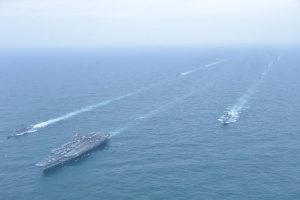The Japan Maritime Self-Defense Force (JMSDF) announced on April 4 that it held a two-day joint exercise with the U.S. and South Korean navies in the East China Sea, in a sign of steadily increasing cooperation among the three services to counter growing North Korean threats.
“The exercise will promote trilateral cooperation to address regional security challenges,” Japanese Defense Minister Hamada Yasukazu said at a regular press conference on April 4.
“It also demonstrates the trilateral commitment of Japan, the United States, and South Korea to protect common security and prosperity and strengthen the rules-based international order,” Hamada added.
The defense minister stressed that the importance of strengthening cooperation among the three countries, including joint exercises, had been reconfirmed at the Japan-U.S.-ROK summit meeting on November 13, 2022, pledging to keep deepening partnerships among them.
The JMSDF said the trilateral exercise, which was conducted on April 3-4, involved a total of eight vessels. The U.S. Navy was represented by the nuclear-powered aircraft carrier USS Nimitz (CVN-68), guided-missile destroyers USS Decatur (DDG-73) and USS Wayne E. Meyer (DDG-108); the Korean Navy by Aegis-powered destroyer ROKS Yulgok Yi I (DDG-992) and destroyers ROKS Choe Yeong (DDH-981) and ROKS Dae Jo-yeong (DDH-977), and logistics support ship ROKS Soyang (AOE-51); and the JMSDF by destroyer JS Umigiri (DD-158).
This is the fourth round of joint maritime exercises the three countries have held near Japan and the Korean Peninsula since Yoon Suk-yeol became Korean president in May of last year. Anti-submarine exercises, involving the nuclear-powered aircraft carrier USS Ronald Reagan (CVN-76), were held in the Sea of Japan, known as the East Sea on September 30. Missile defense exercises were also held in the sea area around Japan in October and on March 22 of this year.
This time, the vessels practiced anti-submarine tactics, simulating a military response against North Korean submarines aimed at detecting, tracking, and destroying them. The three navies also held search and rescue exercises, which were the first such exercises since 2016.
The three nations are under pressure to increase interoperability and cooperation to respond to the underwater threat posed by North Korea. In March, Pyongyang announced that it had launched two strategic cruise missiles capable of pinpoint attacks from a submarine, and that it had conducted a nuclear-capable underwater drone designed to generate a gigantic “radioactive tsunami.” Dubbed “Haeil,” it is believed to be a type of nuclear torpedo, imitating Russia’s Poseidon.
“North Korea is using all kinds of platforms to improve its capabilities, and we must be very vigilant and pay close attention to launches from underwater, which are extremely difficult to detect,” Admiral Ryo Sakai, chief of staff of the JMSDF, said at a press conference on April 4.
The three nations now look to improve capabilities not only for repelling subs but also sharing intelligence.
Although efforts at rapprochement between Japan and South Korea, both U.S. allies, have long been overshadowed by unresolved historical disputes, the recent improvement of the bilateral relationship is beginning to illustrate how vital national security interests supersede issues of the past.

































